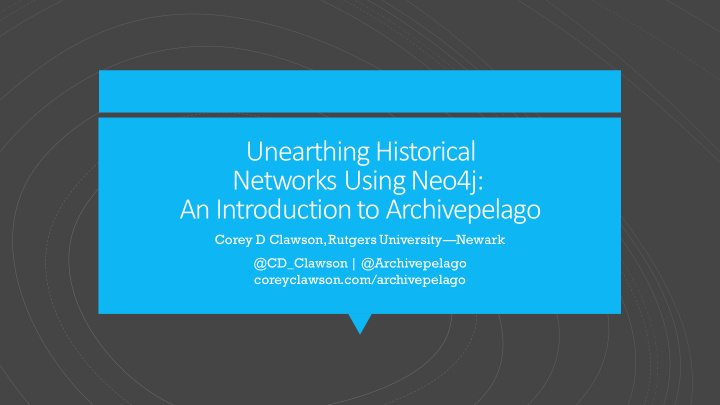



Unearthing Historical Networks Using Neo4j: An Introduction to Archivepelago Corey D Clawson, Rutgers University — Newark @CD_Clawson | @Archivepelago coreyclawson.com/archivepelago
Offer a means of considering/modeling artistic influence Consider the cultural flows of concepts of sexuality and gender Project Goals as well as artistic strategies. Map artistic communities’ formation via processes of migration and urbanization.
Home About ut > News Map Tools The Brooklyn Bridge: a Queer Echo in the Gabriela Mistral: Queer Mother Work of Alfred Corn and Hart Crane for the Nation of Chile Sto tories For Teachers Contr tribute ute Contact Us Us
Home About ut News Map To Tools • Network • Geographic Sto tories For Teachers Include in Inquiry Selected: Hart Crane Contr tribute ute Letters Degrees of Separation: 5 Dedications Translations Display: Standard Romantic Relationships Contact Us Us
Projects with Similar Scopes ▪ Olive Schreiner Letters Online ▪ Six Degrees of Francis Bacon ▪ In the Same Boats ▪ Mapping the Republic of Letters
1. Assemble list of figures with biographical data. 2. Locate initial materials to parse. Focus on letters initially. 3. (We are here) Enter data into Neo4j, start in the 19th century with Whitman, then snowball sample outwards to his connections. 4. Adapt visualization, submission, review tools to the project. Project 5. Aggregate additional biographical data via finding aids Stages and timelines in relevant scholarship. 6. Animate histories of communities emerging (e.g., NYC, Paris, Algiers, SF). 7. Foster collaboration/partnerships, Seek funding to develop into larger public humanities site featuring accessible scholarship.
Primary sources: • Works of literature • Published letters • Published translations • Adaptations of one another's work Sources Secondary Sources • Finding aids outlining contents of primary sources • Work of other researchers
Archives 101: Arbiters/Enforcers of History
Finding Aids
Minimal Content ▪ Dates ▪ Abbreviated Names
POLITICS/SURVIVAL DISPERSION ACCESSIBILITY/LEGALITY CONSISTENCY Challenges to working with historical documents/archives
Initial Thoughts and Revising
Letters to and from Whitman
Documents held by the Beinecke Library at Yale, plus writer and addressee
Letters between Roman Catholics
Mentions of Whitman's "Calamus"
▪ How segregated are networks when taking race into Some of the account? bigger ▪ How central is a figure like Walt Whitman? questionswe ▪ Can we recover lost relationships? hope to consider ▪ And so on.
▪ Project Partner: Andrew Pankratz @ StudioSucreBleu Many thanks! ▪ Professors: Mary Rizzo, Andrew Goldstone, Mark Sincerely, Doty,Michelle Stephens, Ben. Sifuentes-Jauregui, @CD_Clawson Yolanda Martinez-San Miguel, Anne Shifrer @Archivepelago ▪ And of course the organizers and audience.
1. What challenges/obstacles do we face when deriving data from archives? A. Consistency B. Accessibility C. Dispersion D. All of the above 2. The letters used to develop this social network are Hunger Games primarily were written in which century? A. 18th Questions B. 19th C. 20th D. 31st 3. One of the more complicated archival documents discussed today is devoted to a significant writer and his localized network, and it is titled "Finding Aid for (BLANK) and his Literary Circle."
Recommend
More recommend